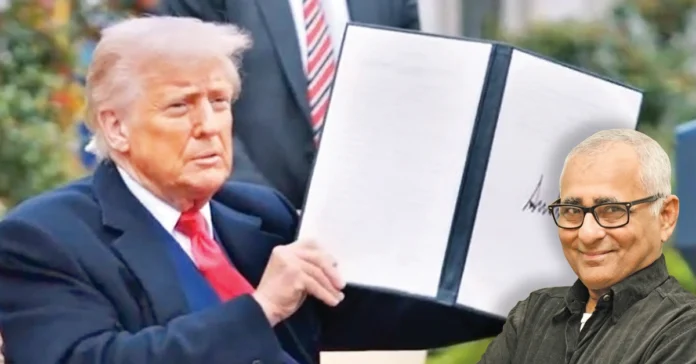By Inderjit Badhwar
When Donald Trump first declared during his campaign that “tariff is the most beautiful word in the dictionary,” it sounded like just another made-for-TV line—provocative, punchy, and designed to make headlines. But six months into his presidency, the words have become policy, and the policy has become a seismic force in the global economy.
This month’s cover story, Trump’s Tariff Tsunami, examines the scale, the strategy, and the shockwaves of a trade agenda that spares no one—not even America’s closest strategic partners.
Trump’s latest executive orders impose a 10 percent “baseline tariff” on all imports into the United States, alongside punitive “reciprocal tariffs” targeting nearly 70 countries accused of unfair trade practices. For India, the numbers are stark: as of August 27, most Indian goods will face a total tariff of 50 percent in the US market. For exporters, this is not a political debating point—it’s a body blow. Sectors like steel, aluminium, copper, auto parts, and seafood will be hit hardest. Trade bodies predict losses running into billions of dollars, with some estimating that US-bound Indian exports could fall by as much as 40 to 50 percent.
But this story is not just about trade. It’s also about how Trump uses economic policy as an extension of his personal brand of diplomacy—transactional, public, and often confrontational. At a time when India-US ties were already grappling with stalled trade talks over e-commerce rules, data flows, and medical device pricing, Trump turned up the heat by publicly chastising India for its continued imports of Russian oil.
The criticism might have carried more weight had it been delivered through diplomatic channels. Instead, it was paired with an unmistakable show of political theatre: announcing a joint US-Pakistan oil exploration venture and speculating, with barely disguised sarcasm, that “Pakistan might sell oil to India someday”. For New Delhi, it was a signal that even a “major defence partner” is not immune from being used as a foil in Trump’s geopolitical messaging.
The Pakistan angle adds a strategic twist to the economic story. While the venture remains, for now, an unproven play in a country with a patchy record of resource development, it could—if credible discoveries emerge—strengthen Islamabad’s economic position and free up fiscal space for defence spending. That would have real implications for India’s regional calculus.
What emerges in our reporting is the intersection of three trends: a president who treats tariffs as both policy tool and political weapon; a global trade system still adjusting to a post-pandemic, multipolar reality; and a US-India relationship increasingly tested by differences over market access, strategic autonomy, and third-party alignments.
For our Indian readers, the impact will be felt in boardrooms and on shop floors—in seafood processing plants in Andhra Pradesh, in textile mills in Gujarat, in auto-parts factories in Maharashtra. For our global readers, the story is a case study in how economic nationalism can ripple outward, disrupting alliances, redirecting trade flows, and reshaping geopolitical balances.
What makes this worth a cover story is not just the immediate hit to trade numbers. It’s the precedent. Trump’s tariff wave is not a one-off negotiation tactic—it’s part of a worldview in which loyalty is measured in public alignment with US positions, and deviation is punished economically. India’s long-cherished strategic autonomy is precisely what makes it valuable to multiple partners—and precisely what makes it a target for this kind of pressure.
We also examine the uncomfortable truth that India’s competitors—Bangladesh, Vietnam, Myanmar—now enjoy lower tariff rates in the US market. That differential could quietly redirect trade away from India, with lasting consequences for its export ecosystem. In the zero-sum logic of Trump’s trade agenda, that’s not collateral damage—it’s part of the leverage.
For world readers, there is a deeper lesson: in an era when economic power can be weaponised overnight, resilience requires more than competitive pricing. It demands diversification of markets, agility in supply chains, and the diplomatic skill to navigate between partners who may be allies one year and adversaries the next.
This story is not about being for or against tariffs, or about taking sides in US domestic politics. It is about recognising that in the interconnected world we live in, a policy announced in Washington on a Wednesday can change the business plans of a shrimp farmer in Visakhapatnam or a steel plant in Jamshedpur by Friday.
As always, our aim is to go beyond the headline and the outrage cycle, to unpack the mechanics, the stakes, and the long game. In doing so, we also remind ourselves—and our readers—that the global economy is as much about relationships and trust as it is about numbers and contracts.
Trump’s tariffs have already redrawn some of those relationships. The question now is whether India can turn the pressure into an opportunity—to accelerate trade diversification, to strengthen regional partnerships, and to assert its economic resilience on the world stage. That will be a story worth telling in the months ahead.


